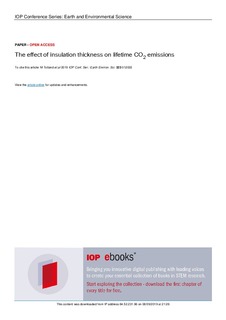| dc.contributor.author | Totland, Marie | |
| dc.contributor.author | Kvande, Tore | |
| dc.contributor.author | Bohne, Rolf André | |
| dc.date.accessioned | 2019-11-25T11:30:30Z | |
| dc.date.available | 2019-11-25T11:30:30Z | |
| dc.date.created | 2019-11-22T13:16:26Z | |
| dc.date.issued | 2019 | |
| dc.identifier.citation | IOP Conference Series: Earth and Environmental Science (EES). 2019, 323 (012033), 1-9. | nb_NO |
| dc.identifier.issn | 1755-1307 | |
| dc.identifier.uri | http://hdl.handle.net/11250/2630246 | |
| dc.description.abstract | This paper assesses the total carbon emissions of a single-family home designed and built for Norwegian conditions, according to current standards (TEK 17), using an LCA approach. Various combinations of insulation thicknesses are assessed to identify which combination is most efficient in lowering the lifetime emissions as well as in which part of the building envelope additional insulation is most efficient in reducing the lifetime greenhouse gas emissions of the building. Overall, increased insulation resulted in lower lifetime emissions; the increased embodied emissions generally being outweighed by the energy savings resulting from the increased insulation thickness. The location of the insulation is the factor that was found to have the largest impact on the lifetime emissions. When increasing the insulation thickness from 100-500 mm, changing only one component at a time, the operational emissions were most sensitive to the insulation thickness in the walls, with a 26 % decrease compared to 7% and 3% for the roof and floor respectively. The most efficient cases tended to have little insulation in the floor (100 - 150 mm) and relatively high insulation thickness in the wall (350 mm). The most variable component was the roof, varying from 150 to 400 mm. | nb_NO |
| dc.language.iso | eng | nb_NO |
| dc.publisher | IOP Publishing | nb_NO |
| dc.rights | Navngivelse 4.0 Internasjonal | * |
| dc.rights.uri | http://creativecommons.org/licenses/by/4.0/deed.no | * |
| dc.title | The effect of insulation thickness on lifetime CO2 emissions | nb_NO |
| dc.type | Journal article | nb_NO |
| dc.type | Peer reviewed | nb_NO |
| dc.description.version | publishedVersion | nb_NO |
| dc.source.pagenumber | 1-9 | nb_NO |
| dc.source.volume | 323 | nb_NO |
| dc.source.journal | IOP Conference Series: Earth and Environmental Science (EES) | nb_NO |
| dc.source.issue | 012033 | nb_NO |
| dc.identifier.doi | 10.1088/1755-1315/323/1/012033 | |
| dc.identifier.cristin | 1751019 | |
| dc.description.localcode | Content from this work may be used under the terms of theCreative Commons Attribution 3.0 licence. Any further distribution of this work must maintain attribution to the author(s) and the title of the work, journal citation and DOI. Published under licence by IOP Publishing Ltd | nb_NO |
| cristin.unitcode | 194,64,91,0 | |
| cristin.unitname | Institutt for bygg- og miljøteknikk | |
| cristin.ispublished | true | |
| cristin.fulltext | original | |
| cristin.qualitycode | 1 | |

